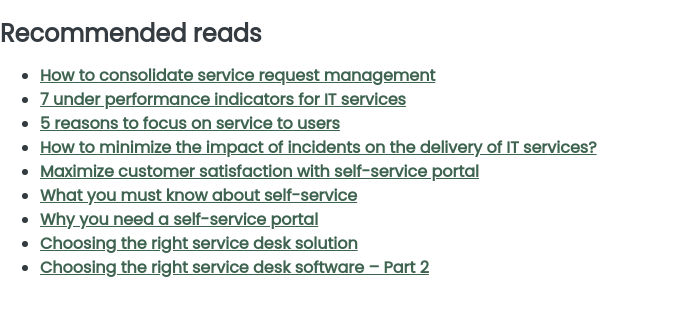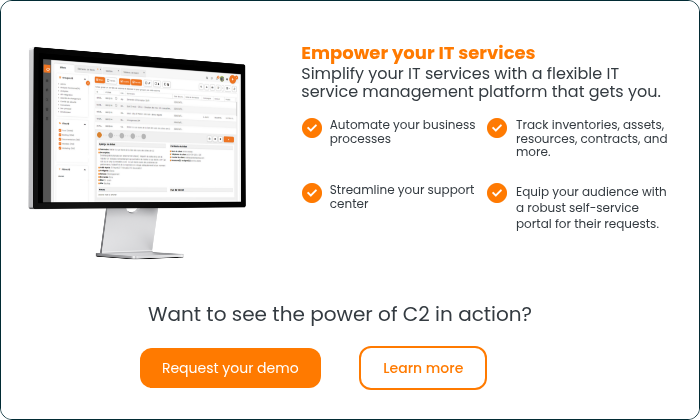
Self-service portals are essential components within IT service management, offering invaluable tools for streamlining workflows effectively. A well-implemented portal can simplify complex workflows faster and more effectively for everyone involved. However, you need to implement it correctly. A poorly implemented portal can significantly drain corporate resources and employees’ time.
So, what exactly is a self-service portal, and why would your company want to implement one? We explain all that and more in this article.
Self-service portals make work easier for everyone
A self-service portal is an interface—today, most commonly a web app—that allows internal and external customers to request different services from your company. For example, an employee could request IT to provide a laptop to a new employee. Or the sales team could request a new company credit from accounting.
Self-service portals are a core component of IT service management processes. Implementing a portal instead of relying on human agents to manage all requests is to resolve common problems and answer common questions as efficiently as possible.
Self-service portals help free up service employees to take on more complicated issues or work on innovations to help the company grow. Once on the portal, customers can help themselves and discover additional content related to their initial inquiry.
Knowledge base articles, frequently asked questions (FAQs), and how-to content are vital components of many self-service systems that help customers help themselves.
Although self-service portal features and requirements vary from company to company, the benefits of using one are essentially the same: faster service at a lower cost while giving your service reps more time to work on higher-order tasks.
Self-service portals are more cost-effective than traditional service teams.
Maintaining help desks and conventional customer service teams means investing significant resources into hiring, training, and supporting staff. Those staff may be highly skilled at untangling complex technical problems or calming down irate clients, but if those situations only account for a small fraction of the calls they field every day, are you getting the best agent utilization possible?
Self-service portals offer a chance to save on staffing costs, improve client satisfaction and redirect human service agents to the calls they’re best equipped to handle.
Self-service portals put your users first.
Today’s business users don’t want to wait on hold. They’re willing to be self-sufficient if it means faster service. Well-designed portals that provide helpful information and expedited service are valuable tools for keeping internal users productive and external customers happy.
They’re always available.
Companies are increasingly employing distributed workforces. This trend was accelerated by the COVID-19 pandemic but had been underway for many years prior. This increase in distributed workforces means having a way for users to request IT services around the clock is more valuable now than ever.
A self-service portal allows remote users to log their requests at any time of day, even in the middle of the night, for your help desk staff. The portal can then guide them through resolving the issue independently or routing their request to the proper service team so they can see it as soon as possible.
Portals help resolve requests faster.
Creating single points of contact is one of the defining best practices of IT service management. Self-service portals are the most efficient possible single point of contact because they enable your users to resolve a wide range of issues before they even need to reach someone at your service desk.
Because your portal tracks everything users and agents enter, you accumulate valuable information about problem types, assets, users and performance trends. You can use this data to make your service desk even more effective.
They allow people to solve problems on their own
Sometimes, your users just aren’t interested in talking to a service agent. Instead, they are delighted to resolve problems independently. That can lead to a reduction in service ticket volumes. Reduced volume allows your remaining service agents to focus on significant issues.
Tailor your self-service portal to your company’s needs.
A self-service portal isn’t a “set it and forget it” IT product. It’s a living IT service in its own right. You’ll need to customize the ITSM portal software you choose for your unique business environment, monitor its performance and adjust it according to emerging trends. Fortunately, reliable self-service portals can do much of this heavy lifting.
Here are three specific things you should do to improve how effectively your self-service portal is adopted.
1. Get the whole organization involved
IT service portals aren’t just for IT. They’re essential tools for meeting business goals across your organization. You need input from stakeholders throughout your company to determine how you want to meet those goals. Senior leadership may have an excellent high-level perspective on how the company runs. Still, it would help if you had feedback from operational staff who can explain what does and doesn’t matter to users on the ground.
Get representatives from every department together and solicit input about what problems a self-service portal might solve. For example, does the sales team need mobile equipment provisioned faster? Does the warehouse team need new accounts created within a certain number of hours of submission? Find out what common workflows hold your company back and determine which ones you can manage through self-service tools.
2. Map out the user experience of your self-service portal before building anything
Good, codeless self-service portals are easy to build and modify. However, you should still develop a solid understanding of how users will navigate the portal before you begin building anything.
You have your business goals sorted at this point. It would be best if you diagrammed the different pathways users will take through your portal—the sequences on menus, selections and text entries they make—when they need to submit a request. Ensure you eliminate any “dead ends” that might trap users with no way to complete their requests effectively.
3. Determine your metrics
A core concept in IT service management is continuous improvement. You need good data to improve. Consider the metrics you want to measure while building your user experience paths. Will the data collected provide meaningful metrics? Will those individual metrics inform your overall ITSM strategy?
Self-service portals are an essential business tool
They’re no longer a “nice to have” component of your service program. On the contrary, ITSM self-service portals are fast becoming crucial for businesses of all sizes.
As IT converges with other business operations and user expectations shift increasingly towards always-available self-service options, an effective self-service portal is a valuable must-have tool for managing your most important workflows.







